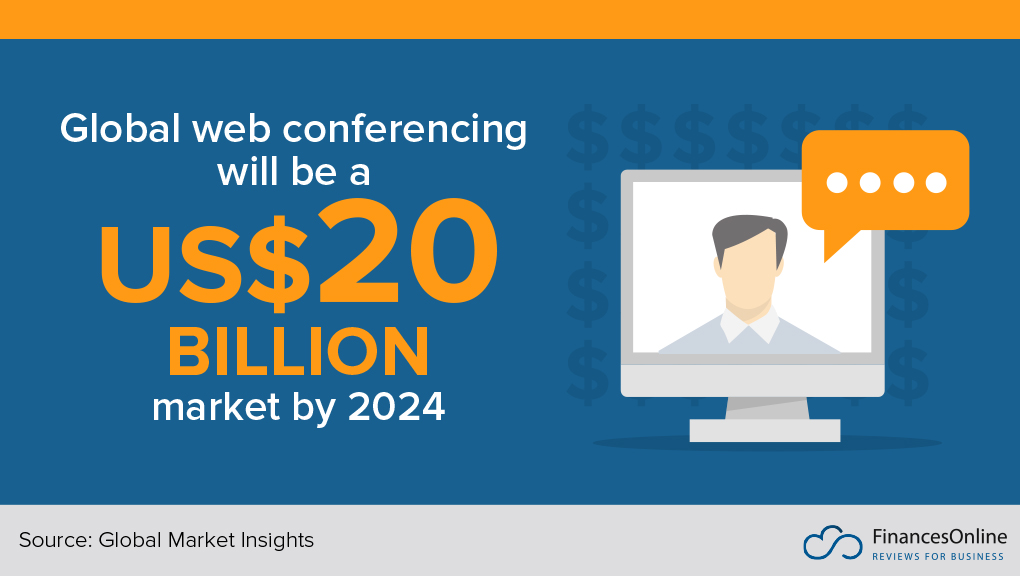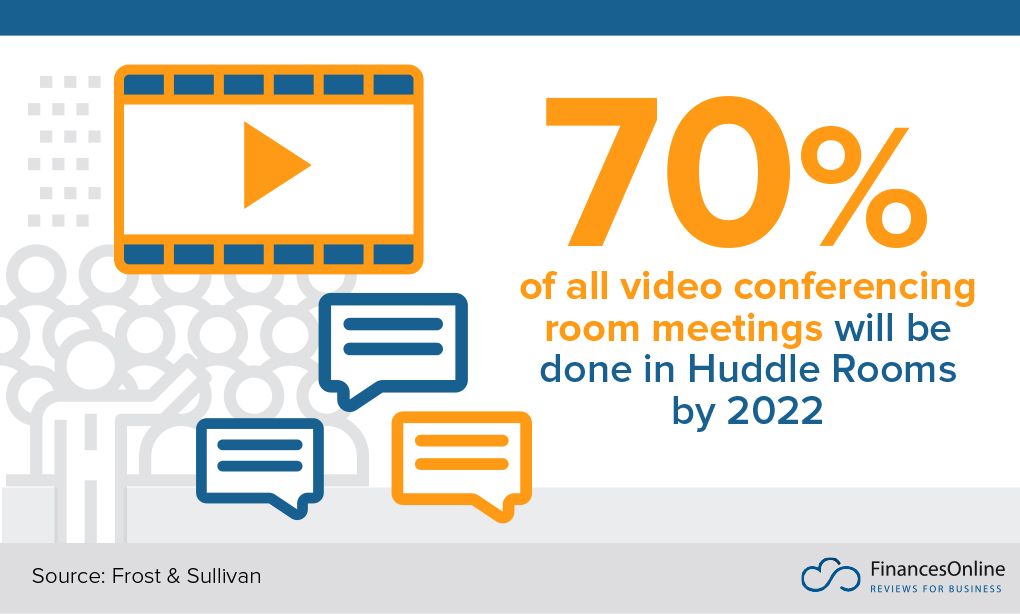A new version of this article, featuring the latest data and statistics is available. Check out our report on Video and Web Conferencing Software Statistics for 2022.
The way people meet and work has changed tremendously. Businesses are no longer limited to the conventional, planned conference room meetings. And with COVID-19 making an in-person meeting risky, people are depending on web conferencing software more than ever. So much has changed in the workplace, but what remains the same, though, is that effective meetings continue to be crucial to business success. These changes are reflected in this compilation of video conferencing statistics and web conferencing statistics.
The video conferencing software statistics we’ve gathered below indicate that technology-powered meetings have increased in value to businesses because they do not only provide convenience and efficiency but also help them gain relevance and competitive advantage.

Video & Web Conferencing Statistics 2020/2021 Table of Contents
COVID-19 & Web Conferencing Technology Statistics
Web conferencing has become the medium of choice for communication for both business and personal purposes. In fact, major corporate organizations have noted that they do not anticipate going back to how operations and jobs are done before the pandemic (Financial News Media, 2020). Here are some general statistics:
- 30% of organizations worldwide began using web conferencing solutions for the first time due to COVID-19. (Twilio, 2020)
- As companies started to instruct their employees to work from their homes, over 100% increases in the use of web conferencing apps were observed in 47 American states in early March 2020. (Blue Jeans, 2020)
- The coronavirus pandemic has hastened the deployment of organizations’ digital communications plans by 6 years on average. (Twilio, 2020)
- 97% of employers think that their digital transformation programs had been accelerated by COVID-19. (Twilio, 2020)
- 4.5% of US adults had used the live video and gaming app to connect with family and friends in March 2020. (Business Insider/eMarketer, 2020)
- 95% of all organizations worldwide are seeking new strategies to engage customers due to the pandemic. (Twilio, 2020)
- 92% of employers across the world report that adapting their digital communications strategy to the current business environment will be key to their survival. (Twilio, 2020)
- 92% of business owners say their organization will likely increase their digital communication channels as restrictions continue to ease across the world. (Twilio, 2020)
Impact of Pandemic on Web Conferencing Apps Statistics
Government lockdowns, social distancing policies, and work from home arrangements during the COVID-19 pandemic had suddenly boosted the demand for web conferencing platforms. Here are some notable statistics:
- 44.1% of adults in the US used Facebook Messenger during the COVID-19 lockdowns. (Business Insider/eMarketer, 2020)
- 47.6% of American adults prefer to use FaceTime when talking to family and friends during the pandemic. (Business Insider/eMarketer, 2020)
- During the start of the pandemic, Facebook announced the launching of a new live videoconferencing solution called Messenger Rooms, which can host a maximum of 50 people simultaneously. (Facebook, 2020)
- 55.6% of all Houseparty users in the US said they had subscribed to the app as a result of COVID-19. (Business Insider/eMarketer, 2020)
- Since March 2020, video calling on WhatsApp and Facebook Messenger had gradually increased over the next months. (Facebook, 2020)
- Zoom was downloaded in a record-breaking fashion across the world: 14X more in America compared to its fourth-quarter weekly average in 2019, 55X more in Italy, 22X more in France, and 20X more in the UK. (App Annie, 2020)
- For iPhones, Zoom downloaded 30X than the previous year in the US starting March 18; it was also the top free app for iPhones. (Medium, 2020)
- From 10 million in December 2019, Zoom’s daily meeting participants increased to 200 million in March and 300 million in April 2020. (Medium, 2020)
- Due to its massive use, Zoom currently consumes approximately 7 million bytes of data per day or 210,000 terabytes per month. (Reuters, 2020)
- The pandemic had also boosted the number of active Microsoft Teams users, reaching 17 million worldwide. (India Times, 2020)
- Likewise, due to extensive remote work, Microsoft Teams now hosts 4.1 billion meeting minutes on a daily basis. (India Times, 2020)
- Since January 2020, the daily usage of Google Meet increased 30x. The app adds 3 million new users and 3 billion video meeting minutes per day. (India Times, 2020)
- Moreover, Webex now hosts more than 22 million meetings a week and a record-breaking number of 324 million attendees. (India Times, 2020).
- During the pandemic, the most significant growth in both Google Play and iOS stores is recorded by business app downloads. (App Annie, 2020)
Source: eMarketer & Business Insider (2020)
Benefits of Web Conferencing Technology Statistics
With video and web conferencing solutions, executives can make powerful sales strategies with company stakeholders, while customer support reps can provide more engaging, face-to-face conversations with clients. And there are more to this list of compelling benefits to businesses, including the following:
- With video conferencing, businesses can cut travel costs by 30%, while 92% of B2B marketers use these tools in their core marketing tasks. (PGI, 2019)
- 66% of executives view mobile video and real-time data-sharing as crucial parts of their day-to-day communication. (Lifesize, 2019)
- 56% of CFOs worldwide plan to invest in video conferencing systems to lessen the need to travel. (PGI, 2019)
- 77.2% of business users are looking to support meetings with remote employees, while 75.7% have multiple offices. (Transparency Market Research, 2019)
- 75% of savings are gained when using cloud-based video services versus traditional hardware multipoint control units. (Lifesize, 2019)
- 75% of CEOs forecast that video conferencing will eventually replace conference calls. (PGI, 2019)
- 58% of businesses utilize video conferencing for their everyday operations. (Lifesize, 2019)
- 83% of large enterprises and 27.6% of small businesses are most likely to purchase video collaboration applications for their operations. (Commercial Integrator, 2018)
- Inadequate work conferencing practices can result in up to $34 billion in losses annually due to low productivity and lost time. (LoopUp, 2018)
- About 50% of employees worldwide are expected to telecommute within a decade or so. (LoopUp, 2018)
Source: Frost & Sullivan
Clearly, the benefits of video conferencing tools will spill over to businesses of all sizes. Businesses typically adopt these communications platforms because of the essential features that they provide, especially their ability to share apps and files, video chat, audio calls, and text messaging/chat. On the other hand, dynamic organizations have already integrated the best video conferencing tools as part of their core business arsenal.
Video Conferencing Software Market Size Statistics
In today’s business world, defined by scattered workforces and global communication, video and web conferencing has become the collaborative tool of choice by organizations everywhere. With video and web conferencing platforms, remote employees and mobile staff can easily collaborate and communicate with their colleagues and business partners in a more immersive way. By helping transform how people in almost all types of endeavors better communicate and operate, video and web conferencing software have been growing fast. They will likely continue their rapid expansion in the coming years.
- 62 million downloads – the record-breaking total of downloads for video conferencing apps in March 2020. (Research and Markets, 2020)
- The worldwide web conferencing market is expected to grow around $19 billion by 2025. (Valuates, 2020)
- Driven by increasing demand for video conferencing apps, enterprise mobile apps had been downloaded 62 million times from March 14 to March 21, 2020; this is the highest ever in history. (Computer World , 2020)
- The global video conferencing market size is predicted to reach a total value of $9.2 billion by 2027. (FnF Research, 2020)
- Video conferencing is part of the Communication Platform as a Service (CPAS) market, which is forecasted to reach $17.2 billion in 2023. (IDC, 2019)
- Pre-pandemic forecast: The video conferencing market share is projected to expand further to reach $13.82 billion by 2023. (Report Buyer, 2019)
- The following year, the web conferencing software market size will go beyond $20 billion by 2024. (GM Insights, 2020)
- Worldwide, the voice and text messaging communications platform-as-a-service (CPaaS) market, which is a significant part of the broader web and video conferencing technology sector, is expected to grow up to $10.9 billion by 2022. (IDC, 2020)
- Pre-pandemic forecast: By 2021, over 80% of global internet traffic will be video. (Martech, 2019)
- Pre-pandemic forecast: The enterprise virtual reality market, another exciting, fast-growing segment of web/video conferencing, is predicted to expand to $5.5 billion by 2023. (Business Insider, 2018)
- From 2017 to 2022, both worldwide IP video traffic and internet video traffic are expected to increase 4X. (Cisco, 2020)
- 20% of meeting room budgetary allocations are now being used for collaborative technologies as businesses further expand support for remote team meetings and other related new work setups. (Future-Resource Consulting, 2018)

By all indications, the global web conferencing market is one of the most dynamic in the entire technology world today. The ever increasing demand for the best cloud-based communications solutions and mobile applications among businesses is a significant driver of this growth. The growing appreciation of business mobility and the implementation of Bring-Your-Own-Device policies also advance the web conferencing market share for these tools. The plunging prices of video and web conferencing products, both software and hardware, are also helping boost this market growth.
Most Popular Video Conferencing Software
- Lifesize. This is a video conferencing suite that delivers enhanced communication for team collaboration and productivity. If you want to know more about this platform, check out this Lifesize review.
- Skype. A simple, yet powerful video conferencing tool for individual and organizational users. This Skype review will orient you more about this efficient Microsoft product.
- Zoom. Another widely-used video conferencing tool that’s user-friendly. Best for businesses that need frequent group messaging, online meetings, and web conferencing. For more details, read this Zoom review.
- Cisco WebEx. A web conferencing tool that facilitates online events and functions as a workspace for project teams. Know more about it by checking out our Cisco WebEx review.
- GoToMeeting. This video conferencing platform helps businesses to bring their dispersed workforce and mobile staff together in a single virtual location. Read our GoToMeeting review for more details.
Future of Video Conferencing Technology Statistics
What does the future of video and web conferencing hold? Whether you’re meeting and collaborating virtually, delivering webinars or online training courses, telecommuting, or talking to a colleague about your upcoming product launch, elevating your use of video and web conferencing solutions is a must to get ahead of your competition. Aside from tapping the strengths of some of the best virtual data room software, an increasing number of innovative video and web conferencing technologies are either getting mature or are about to be deployed for wider use.
As web conferencing continues to further become aligned with collaboration apps—which involves opening a web browser, initiating sharing of videos, desktop screens, etc. with co-workers—more and more businesses are starting to integrate these software solutions in their day-to-day tasks. This emerging use of video and web conferencing technology, along with other current deployments, helps significantly in further cementing the critical role of video and web conferencing in the workplace.
- Integrated Huddle Room Solutions. Presently making up only 8.1% of all video conferencing room meetings, huddle room meetings will increase significantly to reach around 70% of all video meetings by 2022. (Frost & Sullivan, 2019)
- In the near future, huddle room technology is expected to go beyond integrating the best collaboration solutions and video tools into a new class of video and web conferencing solutions completely integrated into project management, ERP, or CRM platforms. This innovative development will allow team members ready access to all business documents and apps, driving higher efficiency, agility, and productivity. (UC Today, 2019)
- The rise of WebRTC. Web Real-Time Communication, a free, open-source technology, is becoming an essential component of web communications technology, mostly deployed for work team collaboration and in the global eLearning market. (Ambient Insight/Statista, 2016)
- Video for B2C communications. As more and more businesses take advantage of WebRTC to embed video into their websites, web conferencing technology is expected to assume a larger function. With this robust B2C approach, business clients will then be able to launch a video call straight from help desk pages and other contact sites. (Accenture, 2019)
- Augmented Reality. Along with the advances of its sister, virtual reality technology, AR was expected to have 83.1 million users per month in 2020, mainly involving video (eMarketer, 2020). By 2024, together with virtual reality (VR), the global AR market is predicted to reach $72.8 billion worldwide (IDC/Statista, 2020).
- Telepresence solutions. Already being deployed to replicate the experience of a face-to-face meeting as closely as possible in a virtual environment, telepresence applications are expected to further deliver a significant impact on the video conferencing market and other related business applications. (Digital Journal, 2018)
- Multi-touch conferencing. A multi-touch model provides businesses with the convenience of enabling teams to access meetings in various ways using different solutions—in ways that best suit their goals—effectively enhances the speed and efficiency of all work collaborators. (UC Today, 2019)
- Facial Recognition check-in. FR is used by numerous onsite registration vendors to significantly lessen event check-in duration. More integrated options for FR are already in test mode to further enhance its use in events. (IACC Online, 2019)
- Wearable technology for attendees. Work teams and event attendees are increasingly using wearable tools like badges, wristbands, and smartwatches to further aid interaction and collaboration. (IACC Online, 2019)
- Real-time data access and integration + analytics. Businesses and events organizers are also tapping into the power of big data and analytics accessible in real-time, for live conference corrections, polling, etc. and even for enhancing the planning of future events. (Events Force, 2019)

The future of business meetings appears to be promising, as the holding virtual reality sessions continue to achieve robust, almost real-life experiences among participants. As emerging technologies like AR, VR, huddle rooms, WebRTC, etc. continue to mature, we can expect that how we hold business meetings today will likely be considerably different and far more engaging in the years to come. It’s also more empowering to have a video and web conferencing solution with other key platforms, as these can inevitably enhance the benefits of CRM platforms to businesses, for instance. What’s quite certain at this juncture, is that the long-standing disfavor with the use of video conferencing over face-to-face meetings will be gone soon.
Leverage these statistics when buying video, web conferencing software
The key video conferencing statistics presented above were selected to adequately inform you where the industry is heading. With how video and web conferencing technologies are enabling people to continue communicating despite the worldwide lockdowns due to COVID-19, it appears that organizations and individuals are likely to embrace this as the new communications norm. In sum, these are the key highlights:
- Being one of the fastest-growing niches in the whole technology market today, the global web/video conferencing market is expected to further expand, promising new and better upgrades for business users.
- Video and web conferencing tools have transformed business communications and collaboration, and will likely continue with new features and benefits.
- Video conferencing will continue to evolve in form and shape and could become the standard in business and industry meetings.
- New technologies like WebRTC, AR, VR, and huddle rooms will collectively elevate the entire video and web conferencing industry to new heights, particularly setting new conferencing norms and benchmarks.
These essential video and web conferencing statistics clearly indicate the current and upcoming state of global video/web conferencing technology and how they are changing the way businesses operate across industries and geographic locations. As a business owner, knowing the extent of the impact of these technologies on the workplace and making timely adjustments to your operations will prove to be pivotal in gaining a competitive edge and success. In case you’re searching for technological solutions to better enhance your distributed work teams’ productivity, it is best to first try some of the best collaboration tools currently in the market before reaching a purchasing decision to ensure you’re making the correct choice.
References:
- Ambient Insight. (2016, July). Worldwide self-paced e-learning market revenue from 2016 to 2021, by region. Statista. https://www.statista.com/statistics/693260/global-self-paced-e-learning-industry-revenue-by-region/
- Ask the Experts: Top Event Technology Trends for 2019. (2018, December 22). Eventsforce. https://www.eventsforce.com/blog/ask-the-experts-the-next-big-thing-in-event-tech-2019/
- Bosin, Z. (2020, March 16). Video Conferencing Usage During the Coronavirus Outbreak. Blue Jeans. https://www.bluejeans.com/blog/video-conferencing-usage-during-coronavirus-outbreak
- Cisco. (2020, March 9). Cisco Annual Internet Report (2018–2023) White Paper. https://www.cisco.com/c/en/us/solutions/collateral/executive-perspectives/annual-internet-report/white-paper-c11-741490.html#_Toc484813989
- Conference Trends 2019: What You Need To Know. (2019, January 23). IACC. https://www.iacconline.org/iacc-blog/conference-trends-2019-what-you-need-to-know
- COVID-19 Digital Engagement Report. (2020). Twilio. https://www.twilio.com/covid-19-digital-engagement-report
- Cox, A. (2018, May 23). 20% of Meeting Room Budget Spent on Collaborative Tech. Future Source. https://www.futuresource-consulting.com/insights/20-of-meeting-room-budget-spent-on-collaborative-tech/
- Daley, D. (2018, July 26). The Video Collaboration Market: Everything You Need to Know. Commercial Integrator. https://www.commercialintegrator.com/communications/collaboration/video-collaboration-market-video-conferencing/
- Enberg, J. (2020, May 12). Live Video Is Replacing In-Person Interactions. Insider. https://www.emarketer.com/content/live-video-is-replacing-in-person-interactions?ecid=NL1009
- Facebook. (2020, April 24). Introducing Messenger Rooms and More Ways to Connect When You’re Apart. FB.Com. https://about.fb.com/news/2020/04/introducing-messenger-rooms/
- Facts & Factors. (2020, December 8). Video Conferencing Market Share to Touch Record Value of USD 9.2 Billion by 2026: Facts & Factors. Intrado GlobeNewswire. https://www.globenewswire.com/news-release/2020/12/08/2141249/0/en/Video-Conferencing-Market-Share-to-Touch-Record-Value-of-USD-9-2-Billion-by-2026-Facts-Factors.html#:~:text=According%20to%20the%20research%20study,11.45%25%20from%202020%20to%202026.
- Financial News Media. (2020, July 17). How the Pandemic Has Become a Windfall for Video Conferencing Platforms. Cision. https://www.prnewswire.com/news-releases/how-the-pandemic-has-become-a-windfall-for-video-conferencing-platforms-301095229.html
- Frost & Sullivan. (2019a). From Breakthrough Technologies to Exponential Growth. Frost.Com. https://ww2.frost.com/research/industry/information-communications-technologies/
- Frost & Sullivan. (2019b). Frost & Sullivan How Cloud is Changing the Video Conferencing Equation. Lifesize. https://legacy.lifesize.com/en/resources/white-papers/how-cloud-is-changing-the-video-conferencing-equation
- Frost & Sullivan. (2019c). Mobile Video Conferencing has Arrived: Extending the Reach of Rich Collaboration Anytime, Anywhere. Lifesize. https://legacy.lifesize.com/~/media/Documents/Related%20Resources/Gated%20Only/Frost%20and%20Sullivan%20Mobile%20Video%20Conferencing%20has%20Arrived.ashx
- IT & Telecom. (2020, April 21). Video Conferencing Market to Reach Valuation of US$16 BN by 2030: Transparency Market Research. Transparency Market Research. https://www.transparencymarketresearch.com/pressrelease/video-conferencing-market.htm
- Jain, R. (2019, January). Global Video Conferencing Market Analysis, Forecast to 2023. Report Buyer. https://www.reportbuyer.com/product/5732638/global-video-conferencing-market-analysis-forecast-to-2023.html
- Kalmykov, M. (2020, July 22). Web Conferencing Boom: COVID-19’s Effect on the Video Call Market. Medium. https://medium.com/swlh/web-conferencing-boom-covid-19s-effect-on-the-video-call-market-153adc2f9d1
- Khanna, M. (2020, May 3). Video Conferencing Is Breaking All Records To Keep Us Connected In This COVID-19 World. India Times. https://www.indiatimes.com/technology/news/zoom-google-meet-microsoft-teams-cisco-webex-video-conference-covid-19-solution-512272.html
- Munroe, C. (2019, October). Worldwide Communications Platform-as-a-Service Forecast, 2019–2023. IDC. https://www.idc.com/getdoc.jsp?containerId=US45534219
- Munroe, C. (2020, May). Worldwide Communications Platform-as-a-Service Forecast, 2020–2024. IDC. https://www.idc.com/getdoc.jsp?containerId=US46287520
- Nellis, S. (2020, April 28). Oracle wins cloud computing deal with Zoom as video calls surge. Reuters. https://www.reuters.com/article/us-oracle-zoom-video-commn/oracle-wins-cloud-computing-deal-with-zoom-as-video-calls-surge-idINKCN22A1R9?edition-redirect=in
- Petrock, V. (2020, April 7). US Virtual and Augmented Reality Users 2020. Insider. https://www.emarketer.com/content/us-virtual-and-augmented-reality-users-2020
- QYResearch. (2020, April). Global Web Conferencing Market Size, Status and Forecast 2020–2025. Valuates Reports. https://reports.valuates.com/market-reports/QYRE-Auto-24L2147/global-web-conferencing
- Regaining eminence & emerging stronger. (2019). Accenture. https://www.accenture.com/us-en/services/communications-media/communications
- Sarnoff, P. (2018, December 19). The VR in the Enterprise Report: How retailers and brands are illustrating VR’s potential in sales, employee training, and product development. Insider. https://www.businessinsider.com/virtual-reality-for-enterprise-sales-employee-training-product-2018-12?IR=T
- SBWire. (2018, January 10). Current Trends and Future Growth of Telepresence and Videoconferencing Market 2017 – 2025. Digital Journal. http://www.digitaljournal.com/pr/3618529
- Schultz, A., & Parikh, J. (2020, March 24). Keeping Our Services Stable and Reliable During the COVID-19 Outbreak. FB.Com. https://about.fb.com/news/2020/03/keeping-our-apps-stable-during-covid-19/
- Strain, K. (2019, August 19). 4 Surprising Stats That Show the True Impact of Video Conferencing. PGI. https://www.pgi.com/blog/2019/08/4-surprising-stats-that-show-the-true-impact-of-video-conferencing/
- Strodl, K. (2018, April 29). Are poor conference call practices costing businesses billions? Loop Up. https://loopup.com/us/resource-center/blog/poor-conference-calls-practices-costing-business-billions/
- Sydow, L. (2020, March 30). Video Conferencing Apps Surge from Coronavirus Impact. App Annie. https://www.appannie.com/en/insights/market-data/video-conferencing-apps-surge-coronavirus/
- Taylor, I. (2017, November 24). Video Conferencing Forecast 2020. UC Today. https://www.uctoday.com/collaboration/video-conferencing/video-conferencing-forecast-2020/
- Tomalin, E. (2019, February 19). Interactive Video: The Smartest Way Forward For Video Marketing. MarTech Series. https://martechseries.com/mts-insights/guest-authors/interactive-video-the-smartest-way-forward-for-video-marketing/
- Trueman, C. (2020, April 3). Pandemic leads to surge in video conferencing app downloads. Computer World. https://www.computerworld.com/article/3535800/pandemic-leads-to-surge-in-video-conferencing-app-downloads.html
- Video Conferencing: COVID-19. (2020). Research and Markets. https://www.researchandmarkets.com/issues/video-conferencing-demand-rises
- Wadhwani, P., & GankarShare, S. (2020, May 19). Video Conferencing Market size worth over $50bn by 2026. Global Market Insights. https://www.gminsights.com/pressrelease/video-conferencing-market























Really great report, I'm building out some data for a current internship project that focuses directly on this material so hopefully my company takes your findings into account via my citation :)
Leave a comment!